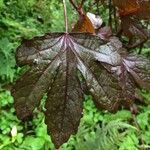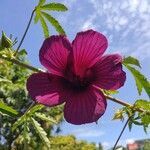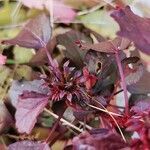Subshrubs, 1–2(–4) m, herbage usually dark red throughout, glabrous, rarely sparsely hairy. Stems with line of fine, curved hairs. Leaves: stipules linear-lanceolate, (8–)10–15 mm; petiole 1/2 to ± equaling blade, with fine, curved hairs adaxially; blade usually dark red, broadly to transversely ovate, usually deeply 3–5-lobed, 4–10 × 3.5–10 cm, base broadly cuneate to truncate, margins crenate or crenate-serrate, apex acute to acuminate, lobes narrowly elliptic or narrowly obovate, surfaces glabrate, prominent slitlike nectary present abaxially on midvein near base. Inflorescences solitary flowers in axils of distal leaves, sometimes together appearing racemose by reduction of subtending leaves. Pedicels jointed near middle, to 1.2 cm; involucellar bractlets 8–10, terete, 0.6–1.6 cm, margins setose, apices 2-fid or appendaged. Flowers horizontal; calyx divided nearly 2/3 length, funnelform-campanulate, 1.2–2 cm, lobes triangular, with 3 prominent ribs, 2 marginal, 1 medial, medial bearing nectary, apices acuminate, veins setose with pustular-based, simple hairs; corolla funnelform-rotate, petals cream, yellow, or dull pink to dull red with veins usually darker pink, maroon basally, asymmetrically obovate, 3–5.5 × 2.5–4.5 cm, margins repand, finely hairy abaxially where exposed in bud; staminal column straight, maroon, 1.5–2.5 cm, bearing filaments nearly throughout, free portion of filaments not secund, 1.5–2.5 mm; pollen yellow; styles maroon, to 1 mm; stigmas maroon. Capsules reddish brown, ovoid, 1.6–2.5 cm, apex acute or short-acuminate, weakly antrorsely hispid with simple, scattered, loose hairs. Seeds olivaceous brown, angulately reniform-ovoid, 3.5–4 mm, papillose-scaly, scales pectinate. 2n = 72.
More
An annual plant. It grows 2-5 m high. It has a few hairs. It has leaves growing close to the ground The leaves are shiny and red or green. They are usually deeply lobed. They are 10 cm long. The flowers are pink. They are in the axils of leaves. The fruit are oval and about 2.5 cm long and have bristles. It can be used as a hedge plant.






